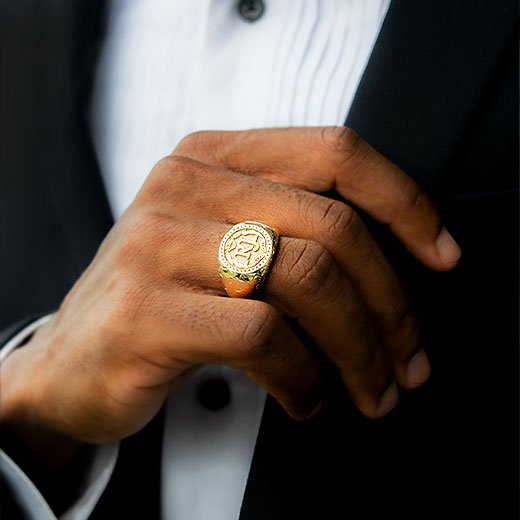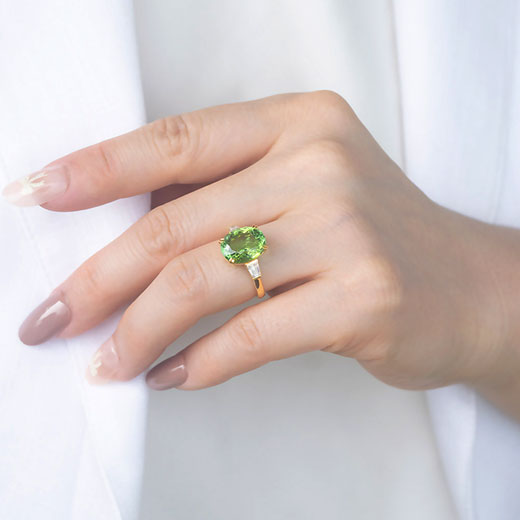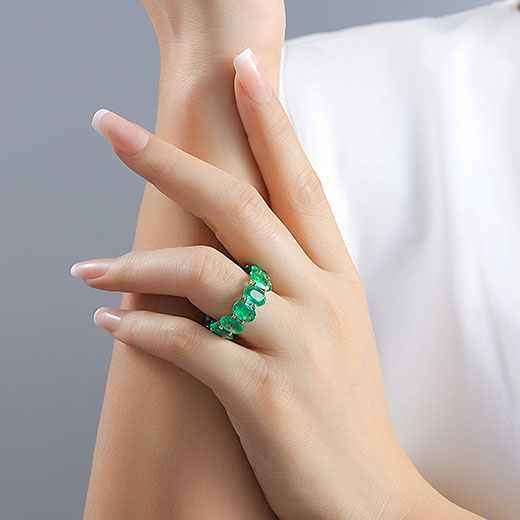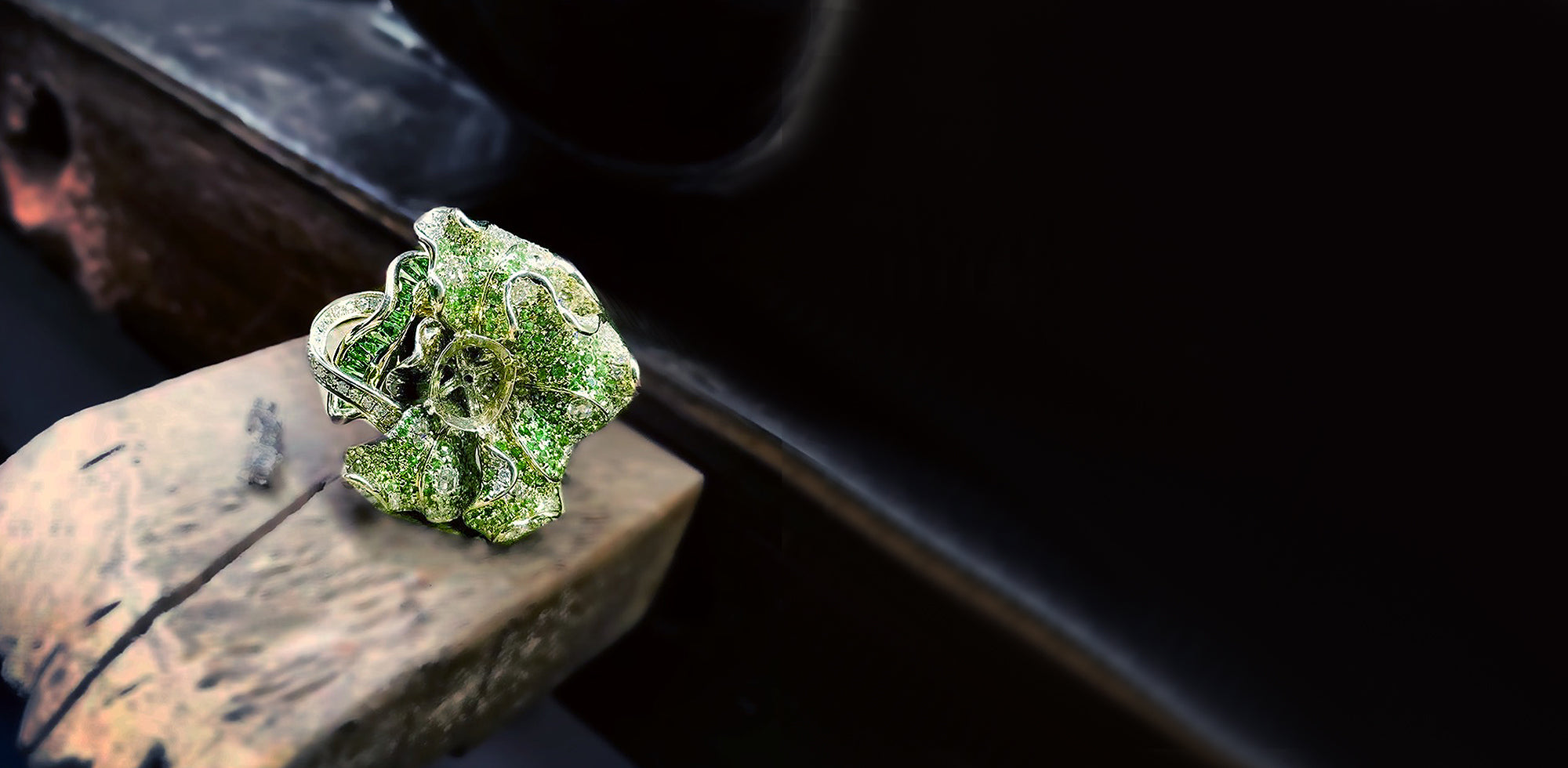Outline
Tanzanite is one of the most fascinating and well-known bluish gemstones in today's gem industry and belongs to the Zoisite mineral group. Not until 1967 that this unbelievably rare gemstone was found at the foothills of Mount Kilimanjaro in Tanzania.
Stories have been told and passed down about how a bolt of lightning once set these foothills (Mount Kilimanjaro) ablaze. Masai herders discovered this violetish blue crystal among the ashes of the scorched land in the aftermath. Soon, this rare gemstone was given the name Tanzanite, named after the country of its origin - Tanzania. This gem is only found in a deep and small area on the mountain's foothills (roughly seven km² in size), making natural Tanzanite a thousand times rarer than diamonds. The stone's rarity, combined with its aesthetic appeal, has contributed to its ever-growing trend among both jewelry designers and consumers.
Although countless myths surround the Tanzanite's birthplace, the truth behind its actual discovery remains a mystery. However, geologists believe that tanzanites are rarely present anywhere else on the planet. It is said that the events that led to its formation around 585 million years ago were so rare that it is virtually impossible to repeat them.
Tanzanite is now considered the second most valuable blue gem after sapphire.
Symbolism
The Tanzanite, and the event that led to its birth, represents the gemstone's ability to transform negative energy into positive energy. Due to its pleochroic nature, Tanzanite appears to change color when viewed from different angles. The fluidity and shifting of color are thought to aid in attaining a higher level of consciousness. Natural Tanzanite is also thought to play a role in mental strength and transforming negative thoughts into positive ones. Natural Tanzanite is considered the birthstone for January borns and the perfect gemstone in celebrating the 24th Wedding Anniversary.
This mesmerizing gemstone of Tanzanite was discovered in the late 1960s and is highly regarded for its kaleidoscope of blue-violet colors. Tanzanite gemstone is given to wives by the Maasai tribes of Tanzania to commemorate a child's birth and bless the newborn with good fortune and prosperity. The gift of Tanzanite at the birth of a child is unique and represents a fresh start.
Properties
Hardness and Strength
On the Mohs scale, Tanzanite has a score of 6 to 7. Fine Tanzanite jewelry is becoming more popular among consumers despite its low rating on the hardness scale. Tanzanite needs proper precautions to be followed to avoid careless wear or impact. Tanzanite also has perfect cleavages, which indicates the gemstone's predilection for chipping or breaking if struck hard enough. Tanzanite is also more prone to cracking due to its sensitivity to sudden temperature changes. However, the jewelry setting and proper care from the owner can significantly reduce the risk of harm.
Treatment
The mineral group to which Tanzanite belongs, zoisite, comes in various colors, including yellow, brown, blue, and pink, to mention a few. The physical resemblance of translucent blue zoisite crystals to sapphire drew immediate attention when they were initially discovered. Following that, laboratory tests were conducted to certify the gem's real identity. Heating was then applied to the naturally blue crystals, which resulted in a more vibrant color. The heat treatment successfully converted the color of naturally brown and green zoisite crystals to blue. These findings resulted in the production of many blue zoisites, which were then commercialized around the globe as tanzanite gemstones.
This gem is usually heat-treated for about 30 minutes at 600 ° C., which is relatively minor compared to other gemstones like sapphire. Under standard exposure to light and in the average temperature range of the human environment, the subsequent change or improvement in color is unlikely to dwindle. Untreated, naturally blue Tanzanite is in high demand and held in high esteem by jewelry collectors.
Grades
Tanzanites, which are versatile and rare, are no longer regarded as a low-cost alternative to sapphire. The low supply of this vibrant and mystical gem has added to its appeal as an heirloom piece, making it a must-have for any judicious jewelry consumer seeking distinction and rarity.
Several factors are taken into account when determining the actual value of Tanzanite. Color, cut, clarity, and carat are all factors to consider.
Color
When determining the value of this gem, color is essential. The most valuable Tanzanites are those with a deep saturated color. Natural Tanzanites with deep blue colors make the top of the list, accompanied by bluish-purple and violet-blue. The value of a tanzanite decrease as the saturation level of the hue reduces.
Clarity
Tanzanites are transparent gemstones with a vitreous lustre that appeals to the eye. They are formed from zoisite crystals that are relatively free of inclusions. As a result, a visible inclusion on a cut and polished gemstone will reduce its value.
The most precious Tanzanite is a large, flawless stone with no inclusions and the highest clarity grade of "eye clean" known as "flawless" is considered as most valuable.
Cut
When viewed from different angles, a tanzanite's pleochroic nature gives it the appearance of having various shades. This property cuts a critical factor in evaluating the gemstone's final and overall appearance. Because blue is usually found on the crystal's short axis, cutting a large bluestone is often more complex because blue Tanzanite is rarer than purple Tanzanite and much more pricey.
Natural Tanzanites come in various shapes and sizes, with the most popular being Oval and Cushion. On infrequent occasions, Tanzanite does have cat's-eye gemstones, which are fashioned into a cabochon(polished but not faceted) to showcase their brilliant effect.
Carat
Large stones with more saturation have the best colors; nevertheless, a large stone with less saturation has a lower value.
Tanzanites can be categorized into the following quality categories based on their properties:
AAAA-Heirloom
Natural Tanzanites in this group are from the top 1% of the world's most exceptionally rare Tanzanites and exhibit an "eye-clean" quality, which means they have perfect and flawless brilliance. Tanzanites with violetish blue color can be distinguished from the rest due to their striking and formidable color.
AAA-Best
This category accounts for nearly 10% of all natural tanzanites on the market. These gemstones are also "eye-clean," with a deep blue color and a purplish hue.
AA-Better
Natural Tanzanites in this group comprises the top 33% of tanzanites on the market. They're a medium violet-blue color and slightly included.
A-Good
This category comprises the top 75% of available tanzanites with slightly to moderately included and is light violet-blue.
Care Guides
Tanzanite jewelry should be handled with caution, as the stone is softer than many other gemstones in the industry. Its perfect cleavage requires that it be protected from hard blows and rough handling. Your Tanzanite engagement ring or Tanzanite earrings will never lose their dazzling radiance if you take proper care of it.
-
Keep your Tanzanite away from other gemstones. A compartmentalized or fabric-lined jewelry box will help keep them separate, reducing friction and scratches with other jewelry.
-
Keep Tanzanite jewelry away from acids and other chemicals, as with all gems.
-
To clean Tanzanite jewelry, use warm water, mild soap, and a soft brush to clean your Tanzanite jewelry gently. After that, a towel or air-dry and avoid using a blow-dryer during drying.
-
Ultrasonic cleaners should be avoided due to the high-frequency vibrations of which can harm the quality of the gemstone.
-
Keep your Tanzanite jewelry out of the sun and away from intense temperatures.
The magical December birthstone, Natural Tanzanite, is a stunning gift from mother earth that truly deserves all its praise. With adequate knowledge and dedication to the upkeep of this gem, you will have a breathtaking piece of jewelry worthy of being passed down to future generations.









